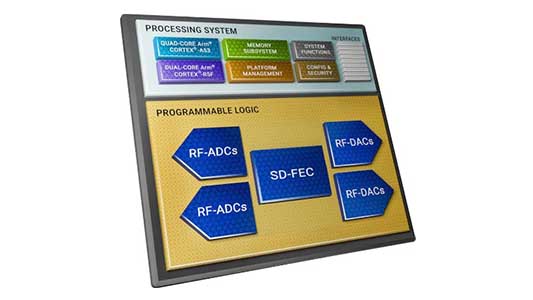Software Defined Radio (SDR) is a transformative technology that replaces traditional analog radio components with digital signal processing controlled by software. This flexibility enables rapid upgrades, reconfigurability, and broad application across defense, 5G, satellite communication, and test & measurement domains.
Unlike conventional radio systems, where signal processing is largely carried out using hardware components such as mixers, filters, and modulators, SDRs leverage software-based digital signal processing (DSP) to execute these tasks. In an SDR system, the analog front end is minimal, typically limited to components like antennas and basic RF front-end circuits. The core processing, including modulation, demodulation, filtering, and decoding, is performed digitally after analog-to-digital conversion (ADC).
The AMD Zynq™ UltraScale+™ RFSoC platform is a powerful building block for SDRs by integrating multi-gigasample RF data converters (ADC/DAC), FPGA, digital processing logic, and embedded software capabilities onto a single chip. This high level of integration reduces design complexity, cuts down on power consumption, and enables performance levels that previously required several discrete components. RFSoC consolidates all these functions into a single monolithic silicon die, delivering ultra-low latency, reduced power footprint, and tight timing control critical for real-time RF applications.
Two defining characteristics of the RFSoC are the extremely high sampling rates that it can support up to multiple Gsps and the wide analogue bandwidths that its RF-ADCs can capture. Similarly, the RF-DACs can generate extremely wideband signals (at least equivalent to the bandwidths of the RF-ADCs). In the context of SDR design, this is incredibly powerful; an SDR can convert between the digital and analogue domains at RF frequencies, enabling a large set of wireless standards and technologies to be supported using an ‘almost all digital radio’ architecture.
Examples of standards that can be directly sampled include, but are not limited to, Wi-Fi bands at 2.4 GHz, 5G New Radio bands around 3.5 GHz and various cellular network bands from 800 MHz to 1.8 GHz.
By comparison, many traditional ‘off-the-shelf’ SDRs are limited to sampling rates of 10’s to 100’s of MHz only, and require an analogue mixing stage to demodulate the above example signals from RF to a suitable IF frequency, prior to analogue-to-digital conversion. Increased fidelity, along with a physically compact design, can be accomplished using an RFSoC-based design approach.
The below figure compares the single chip RFSoC solution against some other possible designs (other variations are possible) — in each case requiring multiple chips.


Figure: Comparison of a single-chip RFSoC SDR solution, with multi-chip alternatives
(The diagrams are sourced from Software Defined Radio with Zynq® UltraScale+™ RFSoC. Read the full book here: https://www.rfsocbook.com/)
Quantitative comparison of single-chip RFSoC vs traditional multi-chip SDR designs.
RFSoC integrates RF ADC/DAC, FPGA, and processors in a unified package, enabling better performance with lower complexity.
| Metric | Single Chip Zynq RFSoC Solution | Two-Chip Solution | Three-Chip Solution |
| Cost | Lowest | ~25–30% higher than single-chip | Highest |
| Development Time | Fastest | Moderate | Longest |
| RF Signal Integrity | High | Medium | Lower |
| Latency | Ultra-low | Medium | High |
| Performance | High | Medium | Variable |
Due to its highly integrated nature, the RFSoC can provide the basis for a much simpler SDR architecture than other alternatives, which would require additional components to perform Digital-to-Analogue (D-to-A) and Analogue-to-Digital conversion (A-to-D). This functionality often forms part of a front-end radio transceiver chip that also performs modulation and demodulation (instances of which are shown in the above Figure. Integration also means that several other components for signal conditioning and interfacing are not required. The integrated nature of the RFSoC family, as well as its many features, results in multiple advantages for SDR design.
Why Consider an RFSoC System on Module?
As RFSoCs integrate high-speed analog and digital processing into a single device, choosing a System on Module (SoM) significantly accelerates development and simplifies complex designs. These SoMs manage challenges such as power sequencing, signal integrity, and high-speed layout, allowing developers to focus on application-level development. This enables rapid prototyping and faster time-to-market, especially for advanced RF and signal processing applications.
In addition, RFSoC SoMs offer a compact, production-ready solution with pre-validated interfaces such as JESD204B, multi-Gsps ADCs/DACs, and high-speed memory. They are ideal for applications that demand SWaP (Size, Weight, and Power) optimization making them suitable for industries like aerospace, defense, wireless communication, and medical imaging.
With flexible carrier card designs and extensive software and hardware support, RFSoC SoMs empower developers to scale across product families while reusing core IP, reducing both risk and development cost.

iWave RFSoC Portfolio

- iG-G42M: ZU49/ZU39/ZU29DR RFSoC System on Module
- iG-G42P: RFSoC ADC-DAC PCIe Card Powered by ZU49/ZU39/ZU29DR
- PCIe Gen3-compatible card with the same RF front-end as iG-G42M
- M.2 NVMe support, multiple SMA I/Os, and FMC+ expansion.
- iG-G60M: ZU48/47/43/28/27/25DR RFSoC System on Module
- Up to 8-channel ADC/DAC (5Gsps/9.85Gsps)
- iG-G60V: ZU48/47/43/28/27/25DR RFSoC ADC DAC 3U VPX Plug in Module (Coming Soon)
iWave is a global leader in the design and manufacturing of FPGA System on Modules and ODM Design Services. With over 25 years of diverse experience in the FPGA domain and a strong design-to-deployment competence, iWave strives to transform your ideas into time-to-market products with reliability, cost, and performance balance.
Looking for more insights? Contact us at mktg@iwave-global.com to explore how our RFSoC portfolio empowers customers with flexible, high-performance platforms accelerates SDR development for customers across domains.












